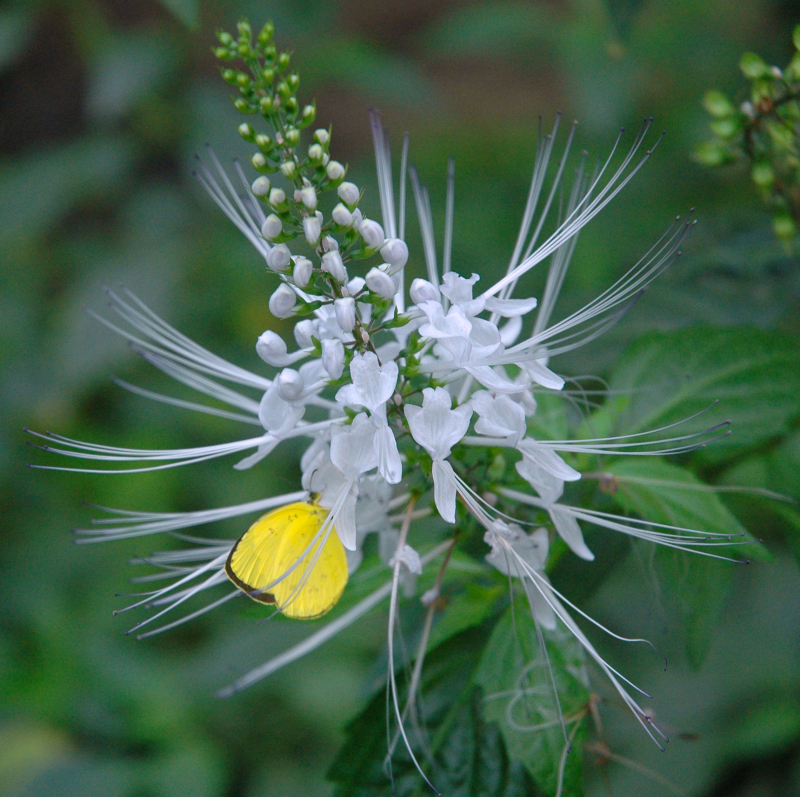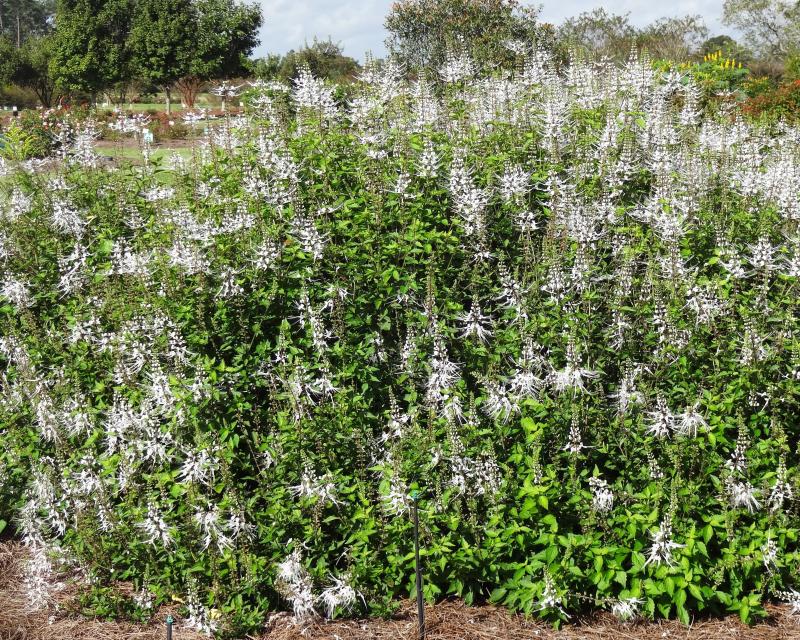During 2015 at Coastal Maine Botanical Gardens, we are preparing to focus our educational programming around the theme of Myth, Magic, and Medicine of Plants. Over the past couple of weeks, our horticulture staff has been researching plants to support this theme. As part of that effort, I dove into the plant listings from some of our favorite nurseries, searching for species that fit the bill. That’s when I rediscovered an old favorite—one I haven’t used in years but absolutely should: cat’s whiskers plant, or Orthosiphon stamineus.
The first time I encountered Orthosiphon was about a dozen years ago when a nursery grower in Wilmington, North Carolina recommended it. In the heat of coastal North Carolina, these plants took off, blooming from early summer through fall. Their unique flowers—delicate white or lavender blooms with long, thread-like stamens extending far beyond the petals—make them unmistakable. They quite literally look like whiskers on a cat’s face, which explains the common name. Back then, they were a garden showstopper, drawing attention from visitors who inevitably asked, “What is that plant?”
A Medicinal Herb with Deep Roots
Beyond its striking ornamental appeal, cat’s whiskers has a long history as a medicinal plant. Native to Southeast Asia and tropical regions of Australia, its leaves are commonly dried and brewed into Java tea (also called “misai kucing tea” in Malaysia and Indonesia). The tea is believed to have diuretic properties, aiding kidney function, reducing water retention, and supporting urinary tract health. Some cultures also use it as a natural remedy for high blood pressure, diabetes, and inflammation. While scientific studies are still catching up to centuries of traditional knowledge, early research suggests that compounds in cat’s whiskers, such as flavonoids and rosmarinic acid, may have antioxidant and anti-inflammatory benefits.

Growing Cat’s Whiskers in the Garden
Despite its versatility, I rarely see cat’s whiskers being grown today, which is surprising given how easy it is to cultivate. It’s a member of the mint family (Lamiaceae), so it shares many of the traits that make mint and other relatives like basil and lavender thrive. Here’s what you need to know to grow it successfully:
- Sun & Temperature: It thrives in full sun but appreciates afternoon shade in the deep South, where summers can be intense. It prefers warm temperatures and is only hardy to USDA Zone 9, so in cooler climates, it’s best treated as an annual or overwintered indoors.
- Size & Growth: When grown from mature plants, cat’s whiskers can reach 3-4 feet tall in a single season, forming an upright, bushy habit. If started from seed, it takes longer to reach full size but still provides a lush presence in the garden.
- Soil & Water: This plant enjoys rich, well-draining soil and appreciates consistent watering—especially during hot weather. While it’s somewhat drought-tolerant once established, regular moisture will prolong blooming and keep the plant looking its best.
- Container Growing: Although I’ve never personally grown it in a container, several sources confirm that it does well in pots. The ability to bring it indoors for winter makes it an appealing option for those in colder regions.
Orthosiphon stamineus – A Unique Addition to Garden Design
Given its lush foliage and constant blooms, cat’s whiskers is an excellent focal point in mixed borders or container gardens. It pairs well with other tropical-looking plants, including coleus, cannas, or elephant ears. The airy, delicate flowers provide a light and whimsical contrast to broader, more dramatic foliage. And because it’s a nectar-rich plant, it’s a great choice for pollinator-friendly gardens, attracting butterflies, bees, and hummingbirds throughout the season.
My Plan for Cat’s Whiskers
Next summer, I plan to use cat’s whiskers as a focal point in our six large Lunaform containers near the visitor center at Coastal Maine Botanical Gardens. I suspect its height, unique flowers, and long-season bloom will make it a standout among our seasonal plantings.
Have you grown cat’s whiskers where you live? If so, how does it do in your area? And if you’ve ever tried cat’s whiskers tea, I’d love to hear what you think.
—Rodney
Images: LSU Ag Center, Butterflyhostplants.com

+comments+